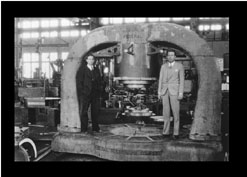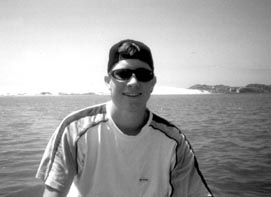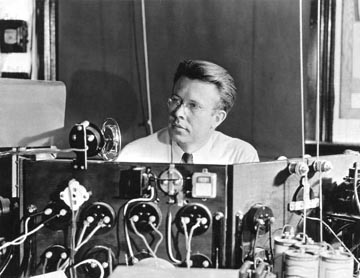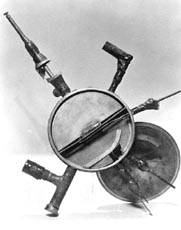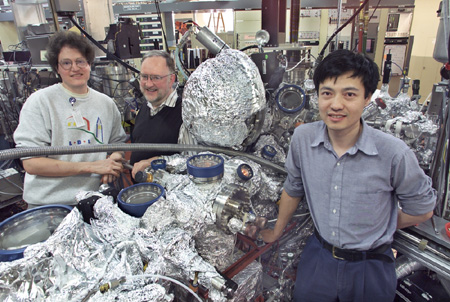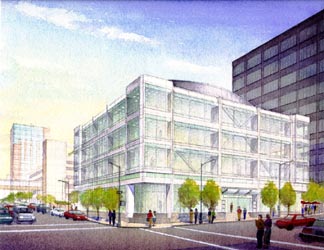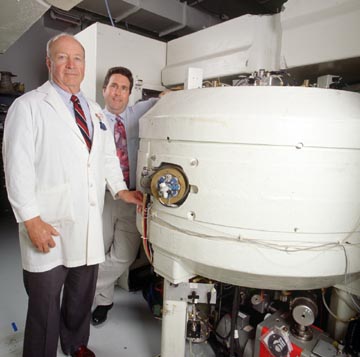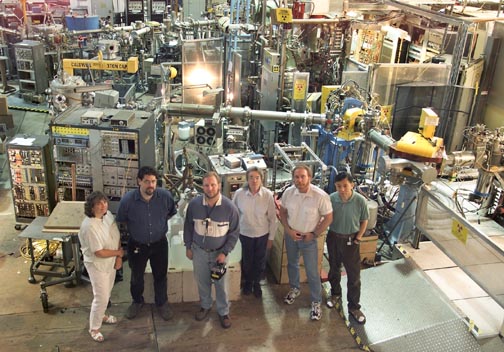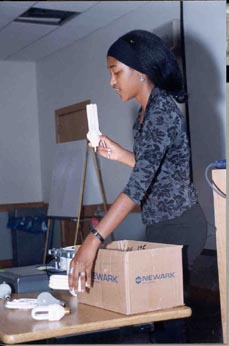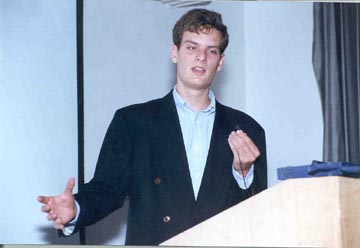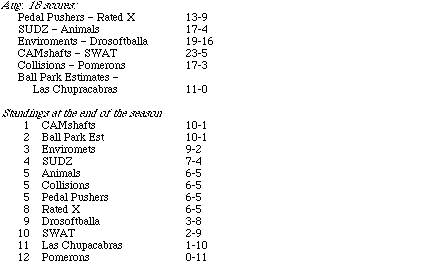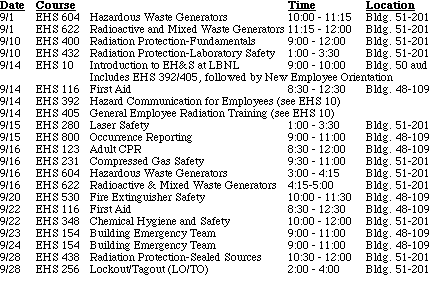
| High Schoolers Put Cyclotron and Berkeley Lab in Historical Perspective |
ALS Research Points To Breakthroughs in Disk Drive Storage |
- Oakland Site Selected for New Lab Computing Facility
- Washington Report
- Jennie Hunter-Cevera Moves to Maryland
- Chang-Lin Tien Appointed to National Panels on Science and Education
- Corrections
- Science News
- Here Come the "BEARS"
- Around the Lab
- Be Part of Currents!
- New Book By Lab Scientist
- Currents Online
- Bulletin Board
- Lab Life
- Calendar of Events
- EH&S Classes - September 1999
- Life Sciences Distinguished Lecture Features Robert Tjian
- Flea Market
- Flea Market Ad Policy
High Schoolers Put Cyclotron and Berkeley Lab in Historical Perspective
By Monica Friedlander
Lawrence's invention of the cyclotron impacted the science of nuclear physics and our knowledge of the atom," concluded the narration as the last vivid images of Ernest Lawrence, Albert Einstein, Berkeley Lab, and the Earth zoomed on the screen to the rousing sound of John Williams' Star Wars score.
"The cyclotron influenced medicine. And finally, it was California's contribution, from its university and its radiation lab, that changed the course of history."
Before the credits started rolling, the audience was on its feet, clapping, cheering, yelling. Everyone wanted a copy of the tape. But this was not the latest sci fi hit of the summer, nor the product of a professional television station, but a physics documentary put together by four teenagers from Bakersfield, California.
The 10-minute video, "The Cyclotron: Smashing Though the Door to the Atomic Age," was produced for National History Day, an annual competition which attracts thousands of students from 48 states. The impact of technology on history was the theme of this year's event, which is sponsored in California by the Constitutional Rights Foundation and nationally by the History Channel. The video won the state competition and advanced to the nationals, held at the University of Maryland this summer.
The students traced the history of the cyclotron and its impact on history -- from its humble beginnings at Berkeley Lab in 1930, when Ernest Lawrence invented his now-famous four-inch glass contraption "sprouting arms and mounted between the poles of an electromagnet," through its role in World War II, and finally to the state-of-the-art medical and scientific applications of today.
"Cyclotron physics is an unknown topic and I think more people should know about it," said Bob Dickson, the lead student on the project. "Lawrence is one of those guys in the back room, but he was a driving force in science and history. I wish people would learn more about what he did, the way they hear about Einstein."
Dickson and his team- mates painstakingly documented the Lab's increasingly larger and more complex cyclotrons -- machines whose magnets help accelerate particles at speeds high enough to break up the atom and release its energy. They explained how Lawrence paved the way for the discovery of heavier elements and their subsequent application in creating the atom bomb.
Finally, they discussed the use of radioisotopes in medicine, an area pioneered by Lawrence's brother, John Lawrence, and the use of the cyclotron in other areas of science, such as astrophysics, which allows scientists to recreate the conditions present at the time of the Big Bang.
For all the seriousness of the topic, the film was not a sterile scientific account, but contained all the elements of a professional documentary: solid content, background music, seamless transitions, computer animation, historical footage, and narration skillfully timed to images. The result was impressive enough for the university-level judges of the preliminary panel at the national competition to place it first. "They told us it should be part of regular high school curriculum," said Sue Grenger-Dickson, the mother of two of the students. "Someone even suggested we send it to PBS."
But by the time the project reached the final panel of judges, made up of high school teachers, the students' luck ran out. For whatever reason, Grenger-Dickson said, two of the three judges found it confusing and placed them eleventh overall.
"When we heard all the cheering and what the other judges said, we thought we had won," said Bob Dickson, who had entered the history contest every year since sixth grade and won in California four times. "We were disappointed but not discouraged. The winning video didn't have the impact on the audience that ours did. That was very important to us."
Moreover, working on this project was not just a valuable educational experience for these young people, Grenger-Dickson said, but it may have influenced the course of their lives, steering her son Bob, now a freshman at UC Santa Barbara, towards a career in physics.
"I think it's sad that the judges didn't understand it," she said. "But it's a chance you take. It was a wonderful experience for the kids. We were thrilled they got to work on the project, made it to the national competition, and had a chance to expose people to the role the cyclotron played in history."
The four students -- Bob, his youn-ger sister Callie, and friends Frances Bae and Daniel Ketchell -- got started by researching the topic on the Internet almost a year ago. They then e-mailed physicists all over the country, who directed them to UC Berkeley and Berkeley Lab.
The students spent three days on the Hill and one on campus, collecting a mountain of documents and primary materials: footage, photographs, historical documents, even Lawrence's letters and papers, which they dug up at UC Berkeley's Bancroft Library.
Most importantly, perhaps, they talked with some two dozen scientists, including physics greats Al Ghiorso, Bernard Harvey and Dave Clark. Ghiorso even extended Dickson an invitation to come back and work at the Lab, Grenger-Dickson said.
"My children are not old enough yet to realize what an opportunity that would be," she says, "or even just to talk to these people and argue with famous scientists about black holes."
In turn, the youngsters were impressed with the scientists -- not just professionally but also for their human qualities. "I found they are all a lot more concerned with the effects of science and technology than most people believe by the way they are portrayed in the media."
After they were done with the research, the high schoolers returned home to Bakersfield to finish the project. "We wrote the script, matched it with the pictures and footage, and made our video in our old junior high's technology lab," said Callie Dickson, who will be a sophomore in high school this fall.
Added co-producer Daniel Ketchell, now headed for college, "It was incredibly rewarding to see the finished product after all the research -- not to mention the countless trips to Taco Bell!"
All along, the Lab effort was coordinated by nuclear physicist Peggy McMahan, who also serves as a tour guide for the 88-Inch Cyclotron and is an avid promoter of science education. Rarely was she as impressed with young people as she was with these four.
"I think I speak for everyone they interviewed here in saying that their enthusiasm and questions opened our eyes as well, and put a new perspective on what we are doing," McMahan said. "I talk to a lot of kids and many of them have no interest at all in what we are doing, starting and ending the tour with a glazed look in their eyes. That makes working with a group of kids like the team from Bakersfield especially fulfilling."
While not all four students plan to pursue a career in science (Daniel plans to be a lawyer and Callie a vet), they all take special personal pride in this project and in the lasting historical legacy of the cyclotron they studied.
"It gave us a broader knowledge of how technology affects society," Dickson said.
Said his mother: "This project would not have been possible without the resources at the Lab and all the scientists who helped out. We are especially grateful to Peggy McMahan for her efforts, and to the Constitutional Rights Foundation that sponsors the contest.
"It is very important for science students to get involved in social sciences, she added. "It gives them a different perspective, and I think my son will be a better scientist for having had this experience."
And some day, Berkeley Lab may in turn benefit from the talents of future scientists whose interest it may have sparked in the spring of 1999.
Student video producer Bob Dickson, relaxing before starting his first year at UC Santa Barbara.
"Lawrence is one of those guys in the back room, but he was a driving force in science and history. I wish people would learn more about what he did, the way they hear about Einstein. Bob Dickson (top left) about Ernest O. Lawrence, shown here in 1938 at the controls of the 37-inch cyclotron."
ALS Research Points To Breakthroughs in Disk Drive Storage
By Lynn Yarris
The recent announcement of molecular-sized computer switches has renewed predictions of hand-held supercomputers in the near future. Practical benefits from dramatically reducing the size of data processors, however, will only be realized if there is an equally dramatic reduction in the size of data storage devices.
A significant step towards downsizing magnetic storage disks has been achieved by researchers working at Berkeley Lab's Advanced Light Source (ALS). They are producing the first high quality images of "quantum wells" -- an energy state in which an electron is sandwiched between two layers of atoms so that its motion is confined to a single dimension.
"As magnetic storage devices become more densely packed with information, reading the data becomes more difficult," says Zi Qiang Qiu, a solid state physicist who holds a joint appointment with the Lab's Materials Sciences Division and the Physics Department of UC Berkeley. "A better understanding of the physics behind quantum well states should enable us to make much more sensitive reading heads for magnetic disks, which in turn, should make it possible to increase disk storage density."
Today's typical magnetic storage device is a plastic disk coated with multiple layers of metallic thin films. Data is stored by converting electrical signals representing the 0s and 1s of the binary code into magnetized areas, called "bits," on the disk's metallic film. Orienting a magnetic bit in one direction represents a 0 and in the opposite direction a 1. The smaller the bits that can be written and read, the more densely a disk can be packed with data.
If all magnetic devices could be pushed into the wavelength limit of an electron moving through a solid -- the nanometer scale -- storage capacity would be significantly raised above that of today's record best. The key is to confine the movement of the electron.
"In our experiments, the movement of the electron is restricted so that it bounces back and forth at an interface, perpendicular to the surfaces, to form a standing wave," says Qiu.
Images obtained at the ALS by Qiu and his colleagues revealed that the amplitude of a confined electron wave is modulated by a mathematical function which surrounds the electron wave like a longer wavelength "envelope." This envelope surrounding and modulating the electron wave determines the energy states of the quantum well. As the electron's wavelength gets shorter, quantum well energies increase, and vice-versa.
Quantum well energy states are believed to be the basis for "oscillatory coupling" and giant magnetic resistance (GMR). Oscillatory coupling relates magnetic orientations in multiple layers of metallic films to film thickness. GMR is the phenomenon whereby exposure to a small magnetic field induces a large change in electrical resistance. Both effects could be crucial to boosting disk storage density.
Manufacturers of magnetic storage devices are already beginning to exploit these effects through structures in which two magnetic layers are separated by a metallic but non-magnetic spacer layer. The technology, however, is in its infancy, and there is much room for developmental improvement. The wave function data being gathered at Berkeley Lab is considered vital to successful development.
For their studies, the Berkeley researchers varied the thickness of their samples by making them wedge-shaped. This technique enabled the scientists to simultaneously vary the thickness of their metallic layers, creating nano-sized electron interferometers for observing quantum well states in each layer.
In one study, they deposited a wedge-shaped layer of magnetized cobalt over a nickel substrate then covered it at right angles with a spacer wedge made of copper. The variation in photemission intensity from a single scan across the sample with ALS light was the result of wave interferences from quantum well states in the two layers.
In another study, a layer of nickel only one atom thick was embedded between two wedges of copper (see figure, left). This enabled the Berkeley scientists to map the amplitude of their wave functions in much the same way that vibrations of a string can be analyzed by lightly touching it at different spots.
"Touching the string at an antinode or at a node causes considerably different effects in the vibration," says Qiu. "By systemically changing the contact position along the string, it is possible to map out the spatial variation of the vibration amplitude. The nickel layer is analogous to the touch of a finger, causing the vibrational modes of our wave functions to respond accordingly."
Critical to the success of Qiu and his colleagues in this work has been the quality of the x-ray beams generated at the ALS. One of the first of the "third-generation" synchrotron light sources, the ALS produces the world's brightest beams of ultraviolet light and low-energy x-rays. These beams are ideal for the study of surfaces and interfaces on a nanometer scale.
Qiu and his colleagues worked at an undulator beamline called the "Spectromicroscopy Facility." The beam at this facility delivers a trillion photons per second, focused down to a spot size of 50 to 100 microns -- about the diameter of a human hair. This tiny spot size makes the detection of quantum interference effects possible.
"We now have sufficient understanding of quantum well states to begin learning more about how these states are coupled with magnetic properties," Qiu says. "Our aim is to reach a level of theoretical understanding and experimental control that will make the wave function engineering of magnetic materials comparable to the bandgap engineering of semiconductors."
Collaborating with Qiu on this project are Roland Kawakami, Hyuk Choi, Ernesto Escorcia-Aparicio, Maria Bowen, Jason Wolfe, Elke Arenholz, and Z.D. Zhang from the UC Berkeley Physics Department; Eli Rotenberg, who oversees use of the Spectromicroscopy Facility for the ALS; and Neville Smith, the deputy for the ALS scientific programs.
Discussions of their work have already appeared in Science, Nature and other scientific journals.
Working at the Spectromicroscopy Facility of the ALS, a team of scientists that included Zi Qiang Qiu (right), Neville Smith (center) and Eli Rotenberg obtained the first high quality images of the electron energy states known as "quantum wells." Photo by Roy Kaltschmidt Oakland Site Selected for New Lab Computing Facility
By Jon Bashor
The Laboratory has selected a site in downtown Oakland to house computers used for both Lab administration and scientific computing. The new Berkeley Lab Computing Center will occupy a former Wells Fargo Bank building at 415-20th Street.
"As computers have become an integral part of how we conduct scientific research, as well as how we manage our Laboratory," said Klaus Berk-ner, deputy director for operations at Berkeley Lab, "it's essential that we have a state-of-the-art computing facility to match our state-of-the-art computers. Although we didn't know what we'd find when we began our search, this new computing center in Oakland fits our needs exactly."
The lease calls for 27,000 square feet of usable space, with an option to add another 35,000 square feet. The building is scheduled to open by the summer of 2000.
The Lab began looking for a suitable site for the computing center earlier this year after it was determined that adequate space was not available on the Hill. The search encompassed dozens of sites, stretching from Hercules to Hayward. A request for proposals in April drew eight qualified responses, from which the Oakland site emerged as the favorite.
The building, which was damaged by the 1989 Loma Prieta earthquake and has long been vacant, will be seismically reinforced.
The new center will house the National Energy Research Scientific Computing Center (NERSC), as well as various computers used by the Lab's scientific programs. Combined, NERSC's one IBM and seven Cray supercomputers have a capacity of performing about one trillion calculations per second and support some 2,500 researchers at national labs, universities and industry to tackle some of the most difficult scientific problems. NERSC also houses a mass scientific data storage center with a capacity of 300 terabytes (300 trillion bits of information) -- more than six times the amount of information in the entire Library of Congress.
Additionally, computers operated by the Information and Computing Sciences Divison to support administrative services -- including human resources, electronic mail and Internet applications, payroll and budgeting -- will be located in the new center. Berkeley Lab has been a leader in adopting new software and technology to support administrative functions across the institution. As a result, the systems are now supported on a handful of powerful, fully supported computers, rather than spread out piecemeal on hundreds of desktop systems.
The move has resulted in greater reliability and lower costs, and allows the central servers to be located off the Laboratory site.
The new center will be connected to Berkeley Lab and other national laboratories via the Department of Energy's Energy Sciences Network (ESnet) a backbone network of the Internet. To provide the needed bandwidth and connectivity, a high-speed network connection will be routed to the new center. Improvements in the electrical supply capability will also be made.
The proposal was approved by the UC Board of Regents at their July meeting.
An artist's rendering of the new building in downtown Oakland, which will house the Lab's new computing center. Washington Report
Task Force Says New Tools Needed for "Complex Systems"
If the DOE is to be a leader in the development of research fields based on "complex systems" -- an approach to research which combines knowledge from various disciplines, including physics, chemistry, materials science and biology -- a new generation of scientific tools will be required. That is the conclusion of a Basic Energy Sciences Advisory Committee task force chaired by Berkeley Lab Director Charles Shank.
"Complex systems are where the future of science will go," Shank said.
The task force began studying the complex systems in October 1998. Understanding complex systems could allow scientists to design a new generation of materials, instead of discovering them by accident, the task force stated in its report. However, the report added, if the DOE is serious about moving forward with complex systems it must commit to developing a new generation of research tools, including computers capable of performing trillions of operations per second. Increased collaborations among DOE, other federal agencies and the academic community will also be necessary.
Copies of the report, "Complex Systems: Science for the 21st Century," are available by calling (301) 903-5565.
Clinton Wants to Triple Use of Bioenergy
President Clinton has issued an executive order that calls on DOE and other agencies to help triple the use of bioenergy and bioproducts in the United States by 2010. The goal is to create fuels and products from plant materials rather than from petroleum and other fossil fuel.
The executive order creates a new council made up of the secretaries of energy and agriculture, the administrator of the EPA, and other agency heads. Its purpose is to develop a detailed bioenergy research program that will be presented to Congress annually as part of the budget request.
Clinton also directed the DOE and USDA to prepare a report assessing options for modifying their existing programs "with a goal of tripling U.S. use of bio-based products and bioenergy by 2010." According to the White House, meeting that goal could create $15-20 billion in new income for farmers and rural America, reduce dependence on imported oil, and cut annual greenhouse gas emissions by 100 million metric tons of carbon equivalent.
The president has requested $242 million for bioenergy agency-wide in FY-2000, nearly $100 million of which would go to DOE programs.
--Lynn Yarris
Jennie Hunter-Cevera Moves to Maryland
By Paul Preuss
Jennie Hunter-Cevera, head of the Center for Environmental Biotechnology, will soon leave Berkeley Lab to assume the presidency of the University of Maryland Biotechnology Institute (UMBI). Although she will not assume her duties until mid-October, Hunter-Cevera is being inaugurated into her new post today at a ceremony in Baltimore.
"Jennie brought tremendous energy and a unique scientific perspective to Berkeley Lab," said Sally Benson, director of the Earth Sciences Division. "We are delighted she is moving on to such a terrific opportunity where she will undoubtably bring all of the enthusiam for innovation that she brought to us."
Mina Bissell, director of the Life Sciences Division said, "We were fortunate to be able to attract Jennie with her multiple talents and energy to initiate the vibrant Center for Environmental Biotechnology. She will be missed."
In turn, Hunter-Cevera thanked Berkeley Lab "for allowing me to grow and learn here," she said. "I look forward to collaborations between the Lab and the Biotechnology Institute that will benefit both institutions."
Earlier this month Hunter-Cevera learned that her appointment had been unanimously approved by the Maryland Board of Regents. She had not applied for the job but was approached by the university, and in the end bested almost 500 other contenders. She replaces Rita R. Colwell, who left the UMBI presidency in 1998 to become head of the National Science Foundation.
A microbial biochemist and a member of both the Earth Sciences and Life Sciences Divisions, Hunter-Cevera has led the Center for Environmental Biotechnology (CEB) since its founding in late 1994. The center, dedicated to basic research in the role of microorganisms in environmental monitoring, human health risks, and biogeochemical transformation of contaminants, unites people and programs in numerous Lab divisions and five departments of UC Berkeley, and collaborates with researchers from several other national laboratories, agencies and universities.
Hunter-Cevera came to Berkeley Lab after having had extensive experience in private industry, including more than 20 years in the field of biotechnology at major firms such as E.R. Squibb and Cetus Corporation, during which she made major discoveries in antibiotics. Her recent research in bioremediation and related areas has taken her as far afield as the Chernobyl reactor in search of novel organisms with commercial potential.
Her scientific studies and her management of the multidisciplinary CEB eminently qualify Hunter-Cevera for her new role. Maryland's Biotechnology Institute has 125 faculty members in five centers, conducting advanced and applied research in marine, medical and agricultural biotechnology and in human virology.
Hunter-Cevera received her Ph.D. in microbiology from Rutgers University in 1978. For the sake of her own children, who will be closer to their grandparents "and all those cousins," she looks forward to returning to the East Coast, though she says, "I'll miss my Lab on the Hill."
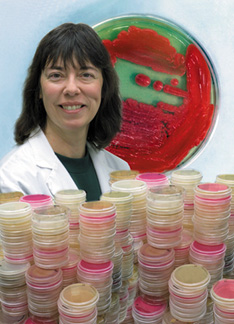
Jeannie Hunter-Cevera
Chang-Lin Tien Appointed to National Panels on Science and Education
Professor Chang-Lin Tien, former chancellor of UC Berkeley and a staff member of Berkeley Lab's Environmental Energies Technology Division, was appointed last month to two national advisory panels on science and education policy.
On July 20 U.S. Secretary of Education Richard Riley named Tien to the National Commission on Mathematics and Science Teaching for the 21st Century, a 24-member council chaired by former senator and astronaut John Glenn. The commission is charged with developing a strategy to raise the quality of math and science teaching in K-12 classrooms. Other members include Senator Edward M. Kennedy and former UC Vice President Walter E. Massey. The commission will submit its findings to Secretary Riley in the fall of 2000.
Also last month, Tien was sworn in as a member of the National Science Board, the governing body of the National Science Foundation. The board sets policy for the NSF and provides advice to the President and Congress on matters of national science and engineering policy.
Also apointed to the National Science Board were Mary K. Gaillard of UC Berkeley and UC Santa Cruz Chancellor M.R.C. Greenwood.
Tien, 64, is one of the world's top experts in the field of heat transfer and thermal science and has served as consultant on major national projects such as the Space Shuttle.
--Monica Friedlander
Corrections
The front page article on "Research Probe Raises Scientific Integrity Issues" (Currents, Aug. 13) incorrectly stated that Berkeley Lab submitted its conclusions about the Liburdy investigation to the Office of Research Integrity in 1997. The report was sent to the ORI on Feb. 2, 1996.
In the story "A Look Back at a Scientific Voyage" (Currents, Aug. 13), the mechanism that produces a Type 1a supernova was mistakenly reported as involving the formation of a black hole. Instead, accretion of material from a companion star onto a white dwarf of sufficient mass results in a thermonuclear explosion that completely consumes the star.
In the story "Tiny Parkfield Quakes Help Lab Scientists Measure Slipping Fault" (Currents, Aug. 13), the photo on Page 3 was taken in 1966, not 1996.
Berkeley Lab Currents
Published twice a month by the Public Information Department for the employees and retirees of Ernest Orlando Lawrence Berkeley National Laboratory. Ron Kolb, PID department head.
EDITOR: Monica Friedlander, (510) 495-2248, msfriedlander@lbl.gov
STAFF WRITERS: Paul Preuss, 486-6249; Lynn Yarris, 486-5375
CONTRIBUTING WRITERS: Jon Bashor, X5849; Allan Chen, X4210, Jeffery Kahn, X4019
FLEA MARKET / CALENDAR: fleamarket@lbl.gov / currents_calendar@lbl.govPublic Information Department, Berkeley Lab, MS 65A
One Cyclotron Road, Berkeley CA 94720
Tel: 510/486-5771 Fax: 510/486-6641
Berkeley Lab is managed by the University of California for the U.S. Department of Energy.
Science News
Here Come the "BEARS"
Medical Cyclotron Pipes Isotope to Building 88
By Paul Preuss
Nuclear Science Division researchers glimpsed a new experimental future early Sunday morning, Aug. 1, when a supply of the radioactive isotope carbon-11, created in the Life Sciences Division's medical cyclotron in Bldg. 56, was piped downhill to the 88-Inch Cyclotron. Within minutes, the radioactive carbon had been ionized to the 4-plus charge state -- stripped of four electrons for a high positive charge -- and accelerated to 110 million electron volts in a beam that delivered a hundred million radioactive carbon-11 ions per second onto a gold target.
It was the first full scale test of the BEARS project: Berkeley Experiments with Accelerated Radioactive Species.
Over the years, nuclear scientists have observed over three thousand of the six thousand atomic isotopes thought to exist, but only 263 of these are stable. Experiments at the 88-Inch Cyclotron using beams of stable isotopes continue to yield important basic knowledge -- and occasional major surprises, such as last spring's identification of elements 118 and 116 and new isotopes in their decay product; yet virtually all possible combinations of beam and target using stable beams have already been explored.
"Back in 1989 the 88-Inch Cyclotron researchers posed themselves a challenge: how to make the 88-Inch into a uniquely valuable instrument for future nuclear research," says Peter Haustein, a visiting nuclear chemist from Brookhaven National Laboratory. Since 1997 Haustein has worked periodically on the BEARS project with its leader Joseph Cerny, a member of the Nuclear Sciences Division (NSD) and a professor of chemistry at the University of California at Berkeley.
Haustein says the 88-Inch group came up with several ideas, including the coupled-cyclotron proposal -- "a relatively cheap and simple method of producing radioactive beams for experiments that cannot be done with beams of stable ions." For example, mechanisms of energy production in some stars -- such as the carbon-nitrogen-oxygen cycle, which involves several short-lived isotopes -- require studying nuclear reactions in which one of the reaction partners is radioactive.
"Our first proposal was to install a second high-current cyclotron right in Bldg. 88. We spent six months in 1989 and 1990 designing that system before other projects took precedence. In 1995 we learned that the Life Sciences Division was installing its own cyclotron for the purpose of producing short-lived isotopes for medical imaging."
When Joe Cerny approached Thomas Budinger, Henry Vanbrocklin, and Jim O'Neil of the new Biological Isotope Facility, Haustein says, "they were happy to join BEARS and share their isotopes with us."
The medical minicyclotron, with its magnet of just 90 centimeters (one yard) in diameter, produces isotopes by bombarding gas or foil targets with a beam of protons accelerated to 11 MeV. Carbon-11 and oxygen-14, two isotopes of interest to the BEARS researchers are produced by bombarding nitrogen.
One problem was how to get the isotopes downhill fast enough to feed them into the ion source at the 88 Inch. The half-life of oxygen-14 is only 70.6 seconds: after one minute and 11 seconds, half the oxygen-14 atoms mixed with the nitrogen have decayed. Carbon-11's half-life of 20.3 minutes makes it a bit more convenient.
Before a delivery system could be designed, however, the coupled-cyclo-tron concept had to be tested. Dennis Moltz of NSD led initial work at the 88 Inch, and recently James Powell of NSD and UC Berkeley has spearheaded a team including Rainer Joosten, Mike Rowe, Daniela Wutte, Z.Q. "Dan" Xie, and other researchers.
The scientists developed a method of trapping isotopes cryogenically in a coil of stainless steel tubing submerged in liquid nitrogen. When the coil is connected to the ion source, its temperature is raised, and the carbon-11 is released in a controlled fashion.
In preliminary tests in "batch mode," carbon-11 in a heavily shielded container was brought down the hill from Bldg. 56 by truck. Transfer was quick enough that useful amounts of the isotope could be injected into the 88-Inch's ion source to test proof-of-principle. In this way Joosten studied the yield of astatine isotopes produced by bombarding gold targets with beams of carbon-11.
Meanwhile work proceeded on a direct method of transporting the isotopes: the capillary transfer line -- a 300-meter-long pipe down Blackberry Canyon. NSD's Eric Norman worked closely with Max Ostas and others in the Facilities Division on materials and design, while Health Physicist Christine Donahue and radiation safety technician Bob Fairchild of EH&S helped with a thorough program of integrated safety management.
The amount of radioactive material in a capillary at any time is modest, and the capillaries are doubly contained inside a continuously monitored, two-inch inner line -- which is under vacuum and equipped with redundant interlocks -- inside a six-inch outer line. The risk of radiation exposure, on or off site, is extremely low under every possible scenario. Under the National Environmental Protection Act, the California Environmental Quality Act, and rigorous safety reviews at Berkeley Lab, the system has been approved at every step of the way.
Finally, computer-automated systems built by Powell and Joosten were installed to track and route the pressurized gas mixed with the isotopes from the medical cyclotron to the cold trap feeding the ion source. Transfer time is approximately 20 seconds. In the efficient new AECR ion source, more than 10 percent of arriving carbon-11 atoms can be ionized to the 4-plus state.
"When we were feeding the ion source with carbon-11 in batch mode, there was no time for the operators to tweak the beam to improve its intensity," says Haustein. "In continous mode, there's plenty of time. During our first full test on August one, it was impressive to see the beam start at low intensity and then grow progressively stronger."
At a hundred million atoms per second on target, the carbon-11 beam is less intense than stable beams, but it's two or three orders of magnitude stronger than the radioactive beams other U.S. facilities have achieved.
Radioactive beams open many experimental possibilities in addition to astrophysics. In some interactions with targets, radioactive beams are expected to have a significant advantage over stable beams in producing desired isotopes with fewer unwanted species to clutter the mix of reaction products. A survey of reaction yields is thus a priority.
A class of uniquely interesting experiments includes the scattering of "mirror nuclei," isotopes of different elements that have the same total number of nucleons -- for example, carbon-11, with 6 protons and 5 neutrons, and boron-11, with 5 protons and 6 neutrons. Because a mirror pair's members have similar nuclear structure, theorists have suggested that unusual resonance scattering effects may occur in their interaction.
"Meanwhile we are beginning to work on what we will call BEARS II," says Joe Cerny, "similar to our original thoughts about installing a second cyclotron inside Bldg. 88. With proton energies up to 30 MeV, we could make several dozens of short-lived radioactive species, up to an atomic mass number of about 80. And with a transfer line only a tenth as long, we could deliver these to the ion source very quickly. Beams of these isotopes could take full advantage of the 88-Inch Cyclotron's capabilities."
BEARS II could be in operation as soon as 2002. Meanwhile BEARS I -- funded mostly by a Laboratory Directed Research and Development Program grant, and an example of a true team effort involving several Berkeley Lab divisions and collaborative efforts of researchers from other institutions -- will soon be working up to 100 hours a month; its beams of highly charged radioactive ions will thus help keep the 88-Inch Cyclotron in the forefront of nuclear research for years to come. n
For more information, visit the BEARS homepage at http://cerny3.lbl.gov/BEARS/ homepage.html.
Top: Thomas Budinger and Henry Vanbrocklin show off the Biomedical Isotope Facility's minicyclotron used in medical imaging.
Left: Pictured at the 88-Inch Cyclotron are Peggy McMahan, Mike Rowe, Bob Fairchild, Ruth-Mary Larimer, Peter Haustein, and Xiaoji Xu - a handful of the many who have contributed to the BEARS project (see website for more). Around the Lab
Be Part of Currents!
Do you have an interesting story or anecdote to tell? Did you or one of your colleagues accomplish something that you think others would like to hear about? Are you working on some interesting research? Do you have a picture you would like published? If so, please send your suggestions to msfriedlander@ lbl. gov. We cannot publish every item submitted, but we will consider all your suggestions.
New Book By Lab Scientist
A new book by David Attwood, head of Berkeley Lab's Center for X-Ray Optics and the driving force behind several ALS beamlines, is due to ship from Cambridge University Press at the end of this month.
Entitled "Soft X-rays and Extreme Ultraviolet Radiation: Principles and Applications," the 488-page volume describes the fundamental properties of EUV and soft x-ray light and discusses the physics of synchrotron, plasma, and laser sources, as well as applications in fields (such as lithography, astronomy and microscopy.
Orders can be placed through Cambridge University Press (110 Midland Avenue, Port Chester, NY 10573- 4930, phone 800-872-7423; fax 914-937-4712, or on the web at http://www.cup.org). The price is $59.95.
Currents Online
The full text and photographs of each edition of Currents are published online at http://www.lbl.gov/Publications/Currents/.
Bulletin Board
High School Interns' Time to Shine
|
Brandy Clark-Smith (left) describes her work in the Lighting Lab while Marcus Graley talks about his project building a Java 3-D image viewer. The two interns were part of Berkeley Lab's eight-week high school Student Research Program, which attracts students from across the Bay Area. The group made their presentations on Aug. 13 in Perseverance Hall. The program is coordinated by Marva Wilkins of the Center for Science and Engineering Education. Photos by Don Fike |
Sports Scores
Golf Club
Results from the Aug. 14 tournament
Softball Club
Playoffs are being held on Aug. 25 and Sept. 1.
Lab Life
Retirement Fete
Berkeley Lab will bid farewell to Manuel Camacho on Thursday, Sept. 23, with a retirement dinner at Chevys Fresh Mex Restaurant in Emeryville (890 Powell Street), starting at 4:00 p.m. The cost is $15 per person and includes dinner and gift. For reservations contact George Rosas at X5643. Please RSVP by Sept. 17.
New Martial Arts Club & Classes
The Employee Activities Association has announced the formation of the LBNL Martial Arts Club. In addition having practical, self-defense applications, the training offer a complete exercise system that focuses on aerobic conditioning, strengthening, coordination, balance, reflexes, and flexibility.
The classes are free and will be offered every Monday and Wednesday beginning Sept. 8, from 5:00 to 6:15 p.m. on the ground floor of Bldg 51. People with previous training are welcome to attend. Individuals with experience are also sought to help run the club.
Classes will be taught by Eric Esarey of the Center for Beam Physics -- a black belt in Tae Kwon Do and Kickboxing and a martial arts instructor for over 10 years. For more information contact him at X5925 or EHEsarey@ lbl.gov.
Swing, Waltz and Cha Cha: Dance Class Comes to Berkeley Lab
Weekly dancing lessons will be offered during lunchtime at Berkeley Lab starting Monday, Sept. 13, from noon to 1:00 p.m. in the lower level of the Bevatron (Bldg. 51). The first in a series of four-week sessions will focus on the waltz and cha cha, with other classes to be scheduled according to the level of interest. Future sessions are expected to include the rhumba, salsa, jitterbug, tango, swing, foxtrot, line dancing and other dances suggested by the participants.
The lessons will be taught by Charlene Van Ness, a professional dance instructor for 18 years, who currently teaches at the Berkeley YWCA.
The cost is either $20 for the four-week session (nonrefundable) or $6 per lesson on a weekly drop-in basis.
Lessons will start promptly at noon. Please come 10 minutes early to sign up for the class on the first day. Early sign-ups are encouraged. To register, contact Joy Kono at JNKono@lbl. gov or Sharon Fujimura at SPFujimura@lbl.gov.
Fidelity Retirement Consultations
A Fidelity Investments representative will meet with Berkeley Lab employees for half-hour consultations on Wednesday, Sept. 8, and Thursday, Sept. 9.
To set up a personal, one-on-one consultation and learn more about Fidelity and their retirement plans, sign up by calling (800) 642-7131. Space is limited, so registration is required. All sessions will be held in the Bldg. 65 conference room.
Travel Parking Reminder
Employees who plan to leave their car onsite while on Laboratory travel are asked to notify the Site Access office at X4551 and leave a completed form in their vehicle. No overnight parking is allowed without advance approval. Questions may be directed to Sue Bowen at ssbowen@lbl.gov.
Craft Fair Update
Employees interested in selling their crafts at Berkeley Lab's annual Craft Fair, to be on Nov.18 this year, may contact Janice Rivera by e-mail at JLRivera@lbl.gov. Sample items will be exhibited in the cafeteria lobby two weeks prior to the event, and photographs of the items will be displayed on the upcoming Craft Fair website.
The committee still needs volunteers to help with organizing the fair. To help out, contact Shelley Worsham at SWorsham@lbl. gov.
Calendar of Events
Aug. 27 - Sept. 10, 1999
General Interest
WED., SEPTEMBER 1
LBNL MAC USERS MEETING
Mac OS Scripting by William Steele
11:00 a.m., Bldg. 90-3148
THURS., SEPTEMBER 2
Shoemobile
7:30 - 3:30, cafeteria parking lot
Tripmobile
11:30 - 2:40, cafeteria parking lot
WED., SEPTEMBER 8
Fidelity Retirement Consultations
Call (800) 642-7131 for a personal appointment
Bldg. 65 conference room
Music Club
1:00 p.m., lower cafeteria
Martial Arts Club
5:00 - 6:00 p.m., Bldg. 51 ground floor
Items for the calendars may be sent via e-mail to currents_calendar@lbl.gov, faxed to X6641 or mailed to Bldg. 65B. The deadline for the Sept. 10 issue is 5 p.m. Monday, Sept. 6.
Seminars & Lectures
AUGUST 27, Friday
Joint CBP-NSD Seminar
"Status of Spiral Project" will be presented by Bernard Laune of Institut de Physique Nucléaire (Orsay) and SPIRAL Group (GANIL, Caen).
10:30 a.m., Bldg. 71 conference roomSEPTEMBER 1, Wednesday
Applied Math Seminar
"Linear Contribution in Nonlinear Dynamics" will be presented by Igor Kliakhandler of Computing Sciences.
4:30 p.m., Bldg. 50A-5132SEPTEMBER 1, Wednesday
Physics Division Research Progress Meeting
"Measurements of the Proton Structure Functions F2 and F1 from Radiative Events with the ZEUS Detector at HERA" will be presented by A. Bornheim of Bonn Uni-versity.
4:00 p.m., Bldg. 70A-3377SEPTEMBER 2, Thursday
Physics Division Research Progress Meeting
"HERA Collider Physics" will be presented by Allen Caldwell of Columbia University.
4:00 p.m., Bldg. 50A-5132SEPTEMBER 2, Thursday
Astronomy Colloquium
"How Difficult Is it to Build a Habitable Earth-like Planet?" will be presented by Stuart Taylor of Australia National University.
4:30 p.m., 2 LeConte HallSEPTEMBER 7, Tuesday
Center for Environmental Biotechnology Seminar
"The Evolutionary and Ecological Physiology of Communities at High Temperatures" will be presented by Anna-Louise Reysenbach of Rutgers University and Cook College.
Noon, 338 Koshland Hall, UC BerkeleySEPTEMBER 9, Thursday
Physics Division Research Progress Meeting
"The BBar Mixing" will be presented by David Jackson of SLAC.
4:00 p.m., Bldg. 70A-3377SEPTEMBER 9, Thursday
Astronomy Colloquia
"Delivery of Asteroids and Meteoroids to the Inner Solar System" will be presented by William Bottke of Cornell University.
4:30 p.m., 2 LeConte Hall, UC Berkeley
EH&S Classes - September 1999
For more information or to enroll, contact Susan Aberg at Saberg@lbl.gov or enroll via the web at http://www-ehs.lbl.gov/ehstraining/registration/. Preregistration is required for all courses except EHS 10 (Introduction to EH&S). Times and locations are subject to change. For a full, updated schedule of EH&S training sessions see http://www-ehs.lbl.gov/schedule/.
Life Sciences Distinguished Lecture Features Robert Tjian
"The Biochemistry of Eukaryotic Transcription" will be the topic of a special lecture to be held on Tuesday, Sept. 21 in the Bldg. 66 auditorium. The speaker will be Robert Tjian, a professor of molecular and cell biology at UC Berkeley and an internationally-recognized expert in the field of transcription factor biochemistry.
Tjian currently chairs the New Biology Partnership Committee founded by Lab Director Charles Shank to foster major initiatives between Berkeley Lab and UC Berkeley in the field of biosciences. He is also the founder of Tularik Inc., a company engaged in the discovery and development of new drugs.
Flea Market
Autos / Supplies
`56 CHEVY 4 dr station wgn, white, 40K mi on rebuilt engine, manual trans, body/paint/mechanical exc cond, inside fair, $4,500, Viki, 549-1876`69 DATSUN 4 dr station wgn, std shift, body/paint/mechanical exc cond, inside fair, $1,000, Viki, 549-1867
`82 AUDI coupe, white, 140K mi, runs good, new brake/tire/ batt, dent in pass dr, $800/b.o., Frieder, X4213, 658-6431
`85 TOYOTA Camry, 4 dr, auto, ac, pwr steer/brake, am/fm/cass, 135K mi, new batt/timing belt, runs fine, weak paint, $1,000/ b.o., Peter, X4157, 525-3290
`86 HONDA Accord DX, 138K mi, 5 spd, 4 dr, orig owner, $2,000/b.o., Paul, X5278, (925) 947-2360
`89 TOYOTA Camry LE, V6, 83K mi, auto, ac, pwr wndw/steer/ lock/sunrf, cruise, am/fm/cass, avail 9/25, $5,000, Uli, X5265, 559-8794
`90 FORD Taurus station wgn, 1990, 3L V6, pwr lock, radio/ tape, new susp/pwr steer/spark plugs/alternator, avail begin of Oct, $4,500, Sylvain, X7030
`90 MAZDA 323, 4 cyl 1.6L engine, 70,840 mi, interior good, timing belt and CV boots changed, $2,100/b.o., Isabelle, 653-8154
`90 MAZDA Protege, 4 dr, 126K mi, auto, ac, am/fm/cass, runs fine, $1,600/b.o., Winnie, X6634, (925) 934-2809
`92 EAGLE Summit LX wgn by Mitusbishi, auto, 116K mi, ac, am/fm/cass, white, 2.4L, 4 cyl, very neat, runs great, $3,200, Hiroshi, X5763, 527-0962
`92 FORD Explorer, blk, 61K mi, 2 dr, 5 spd, 4x4, perfect cond, exc care, 1 owner (moving) price neg, Ken, (415) 504-9597
`96 SATURN SW2 wgn, fully loaded, dark purple, custm metallic wndw tint, 50K mi (mostly interstate), $12,000, Bob, X2278, (707) 446-7933
`97 ACURA CL Premium, blk, 2 dr coupe, auto, 6 cyl, 3.0 L VTEC, leather, sunrf, Bose stereo sys w/ CD, dual airbags, alarm, about 9 mo left on warranty, 52K mi, $16,500/b.o., Albert, X4927, 665-8119
Motorcycles
`77 HONDA GL-1000 w/ fairing and bags, lots of new parts incl elec ignit, runs great, $1,500/b.o., Roy, X7592, (707) 747-1909`80 HONDA CX-500, 500cc, shaft drive, water cooled, plexi fairing, backrest/luggage rack, good commute bike, b./o., Bob, (925)376-2211
Housing
BERKELEY, 2 bdrm furn apt in Victorian house, Wheeler St near Berkeley Bowl Market, close to campus, shuttle, BART, $1,250/ mo, util incl, share gardens, basement storage & laundry w/ owner, clean, light, prefer quiet single or couple for 9 mo or 1 yr, 2 yrs possible, Ann, X6985BERKELEY, Elmood area, furn 1 bdrm, split-level, linen, dishes, HiFi, VCR, microwave, sunny, quiet, safe, walk to UC, hill view, lg terrace, garage, pref 1 mature, nonsmoking visiting researcher, min 10 mo, $880/mo, leave name, phone/e-mail, 843-6325
BERKELEY HILLS, modern studio in architect designed home on edge of Tilden Park, very quiet/private, own deck/entrance, free parking, dishwasher, fridge, lg bthrm, Murphy bed, security sys, close to lab, bus #65, 1 person only, no smokers/ pets, $900 +elec, avail 9/1, Evan, 486-6784
BERKELEY HILLS studio, Campus Dr, 5 min walk to Lawrence Hall, separate entrance, deck, nice view, microwave, fridge, no kitchen, full bth, 2 nice-sized closets, $750/mo + deposit + 25% util, Ali, X7159, 845-4624
EL CERRITO HILLS, furn room, bay view, household privileges incl use of washer/dryer, kitchen, 15 min from lab, $600/mo, Larry, X5406, 237-3321
ELMWOOD, share elegant 11 rm house w/ 2 men, 1 woman, non-smoking professionals, $600/mo + dep, shared exp, $745 for mstr bdrm w/ fireplace and huge closet, piano, yellow Labrador, laundry, sauna, hardwood flrs, exc neighborhood, woman pref, Tony, 841-4480
PLEASANT HILL, 3 bdrm, 2 bth, 1,800 sq ft, well maintained, updated single story home on quiet secluded court w/ private serene backyard, great for entertaining, central heat/air cond, formal living and dining rm, family rm w/ brick fireplace, decks, spa, gazebo, motivated seller purchased new home, $379,950, Kathy, X4903, (925) 685-5659
Miscellaneous
49er TICKETS, sec 6/row 2, seats 18/19, $150 pair, cash only, 11/21, St. Louis Rams, 12/26, WA Redskins, Sheryl, X5126AQUARIUM, 30 gal, plexiglas hex tank w/ 30" wooden stand, $40, Dave, X4506
BASSINET w/ Noah's Ark print, exc cond, $45, Michael, 237-1609
CEDAR FLUTE (Nat Amer style), easy to play, instr incl, $50/b.o. ($100 new), Steve, X6941
CHILDREN'S CLOTHING (girl, sz 6), Oshkosh: shorts, skirts, dress, short overalls, 8-10; Gymboree shorts, dresses, t-shirts & jacket; car booster seat for older kids, Edith, X5553
DESK, rolltop, Danish style, 4 drawers, space for computer or typewriter, b.o., Lucy, 524-0075
DISHES, stoneware by Wedgwood, "Midwinter" pattern, 12 ea dinner, bread/butter, 11 cups/ saucers, 8 salad, 7 bowls, serving pieces, dishw/micro safe, $50; placemats, napkins, napkin rings, Harvard, 526-5347
FIBERGLASS POND, figure-eight shape, used, gd shape, approx 9'Lx5'Wx18"D, $125, Dennis, X7859
GARAGE SALE, multi-family, 8/28-29, 8:30-4:30, 700 block of Washington, Albany, Paul, X5902
GAS STOVE, 4 burner, apt size, Magic Chef, exc cond, $125, Viki, 549-1876
GLASS TABLE, round w/ 4 off-white padded chairs, $100; papa-san chair, beige, $40; 3-seat couch, great shape, old style, $40; Japanese blinds (2), blk wood w/ white screens, $25 ea, negotiate transp, Scott, X4874
LASER PRINTER, Packard Bell 9815, $125; Printshop Ensemble (Mac), $10; men's tennis shoes, size 10, used once, $10, Ken, X7739, 482-3331
MOVING SALE, double bed mattress+base, $200; coffee table, glass/wood, $50; bedside table, $35; TV table, $35; shelf, $35; bookcase, $20; food processor, fondue set, table lamp, phone, elec alarm clock, citrus juicer, Sylvain, X7030
MOVING SALE, full-size bed, futon, kitchen table, study desk, bike rack, all 1-2 yrs old, Jamal, X5652, 233-4599
MOVING SALE, dresser, 5-drwr, pine, exc cond, $95; TV, 13" Samsung, $60; lamps (desk and halogen), vacuum, elec mixer, blender, mirror, more, Isabelle, 653-8154
MOVING SALE, 21" TV, Panasonic, $90; Sony playstation, $55; 15" monitor, $75; 4 folding chairs/table, $30; desk, 4 drwrs, $15; sm table, $10; 4 wooden chairs, $25 or $8/ea; chair, $10; futon, $25; queen mattress+ boxspring, $30; iron board, shelves, lamps, cooler, coffee maker, grill, patio lamp, pots, plates, mugs, more, Winnie, X6634, (925) 934-2809
MOVING SALE, 21 gear bicycle, 1.5 yrs old, $130 ($300 new); boom box incl cass/CD, $40; Frieder, X4213, 658-6431
WOODEN PLATFORM BED, twin, blond, storage drawers, $50, Susan X7366.
ROLLAWAY BED w/ mattress, twin, mint cond, $45, Maggie, (925) 837-3914
ROTOTILLER, Troy-Bilt 5 hp, 2 spd, pony model, 20 yrs old, $350/b.o., Suzanne, 524-1953
SERVICE, interior painting, free estimate, Rita, X5621, 465-3813
SF OPERA TICKETS, 9/16 - Louise, balcony front, 2nd row, $84 pair, Paolo, 524-8215
SNARE DRUM, brand new, $130, Manouchehr, (925) 631-0510
STEAMER TRUNK, antique upright, $75; Casio keyboard, $40; piano accordion, $35; Stu, 525-2367 (eve)
STEEL CUPBOARD, 2 dr, green, 5 shelves, b.o., Lucy, 524-0075
TV, 13" Hitachi, $95; VCR, Symphonic system, VHS, $125; folding table+chair, $22; Roadmaster bicycle, $35, ironing board, elec grill, waffle iron, hair dryer, radio alarm clocks, dig displ, bthrm scale, juice maker, Andreas, X5453, 845-4672
YARD SALE, 3 families, 9/12 - 13, furniture, gardening equip, misc, 2131 Rose (Oxford & Walnut), 10:00-3:00, Viki, 549-1876
Wanted
CAR, 1988+, gd cond, $3,000 - 4,000, auto, ac, pwr package, Gretchen, X4370, 524-2327CAR OR MINIVAN, 6 seater for 1 yr visiting researcher w/ 4 children, around 9/9, X6684
CARPOOL, Vacaville/Fairfield (RT) to lab, Marcella, X6304
HOUSING, room or apartment, for visiting female postdoc, 8/27 to 10/4, can share, house/dog sit, s_cenci@usa.net or Alex, X5050
PHYSICS STUDENT to escort Mr. Chamberlain to campus seminars, occasional Mondays, 3:30 - 6 pm, must drive and be able to assist w/ mobility impairment, Senta, 524-4654
Vacation
TAHOE TYROL at So Lake Tahoe, spacious chalet, close to Heavenly, peek of Lake from front porch, fully furn, sleeps 8+, close to casinos, shopping, more, $155/day, Pat, 724-9450Lost & Found
FOUND: gold pendant w/ religious motif along road in June, Amy, X2465
Flea Market Ad Policy
Ads are accepted only from Lab employees, retirees, and onsite DOE personnel. Submissions must include name, extension, and home phone and be submitted in writing (fleamarket@ lbl.gov, fax, X6641, MS. 65B. The deadline for the Sept. 10 issue is Friday, Sept. 3.
